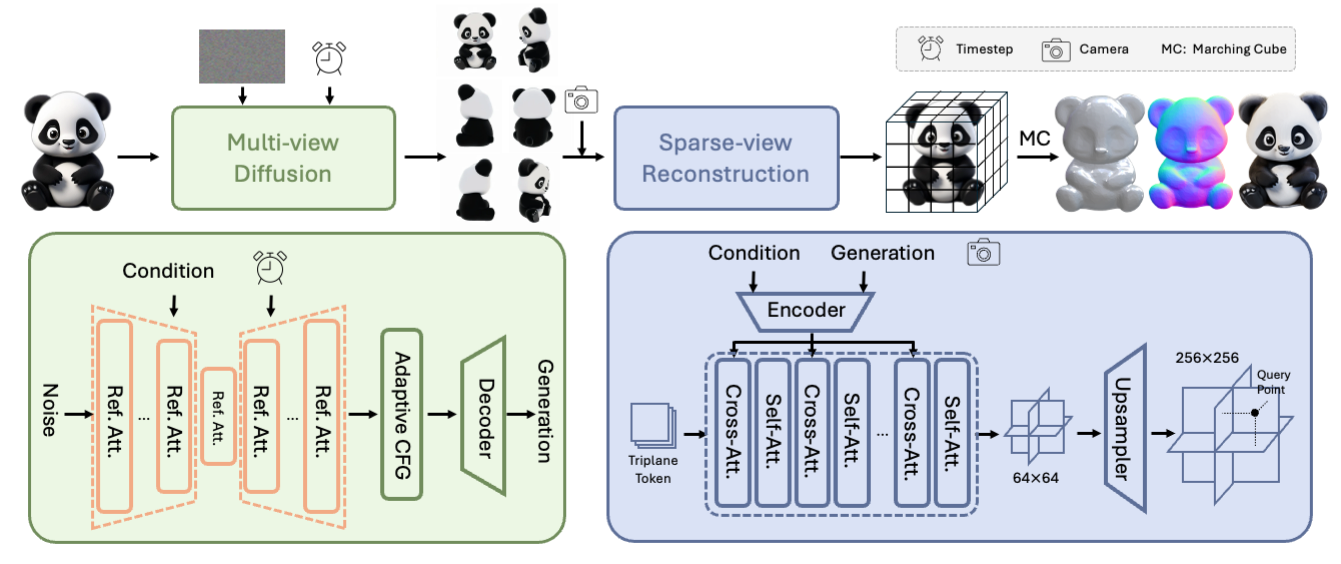6.9 KiB
Tencent Hunyuan3D-1.0: A Unified Framework for Text-to-3D and Image-to-3D Generation
🔥🔥🔥 News!!
- Nov 5, 2024: 💬 We support demo running image_to_3d generation now. Please check the script below.
- Nov 5, 2024: 💬 We support demo running text_to_3d generation now. Please check the script below.
📑 Open-source Plan
- Inference
- Checkpoints
- Baking related
- Training
- ComfyUI
- Distillation Version
- TensorRT Version
Abstract
While 3D generative models have greatly improved artists' workflows, the existing diffusion models for 3D generation suffer from slow generation and poor generalization. To address this issue, we propose a two-stage approach named Hunyuan3D-1.0 including a lite version and a standard version, that both support text- and image-conditioned generation.
In the first stage, we employ a multi-view diffusion model that efficiently generates multi-view RGB in approximately 4 seconds. These multi-view images capture rich details of the 3D asset from different viewpoints, relaxing the tasks from single-view to multi-view reconstruction. In the second stage, we introduce a feed-forward reconstruction model that rapidly and faithfully reconstructs the 3D asset given the generated multi-view images in approximately 7 seconds. The reconstruction network learns to handle noises and in-consistency introduced by the multi-view diffusion and leverages the available information from the condition image to efficiently recover the 3D structure.
Our framework involves the text-to-image model, i.e., Hunyuan-DiT, making it a unified framework to support both text- and image-conditioned 3D generation. Our standard version has 3x more parameters than our lite and other existing model. Our Hunyuan3D-1.0 achieves an impressive balance between speed and quality, significantly reducing generation time while maintaining the quality and diversity of the produced assets.
🎉 Hunyuan3D-1 Architecture
📈 Comparisons
We have evaluated Hunyuan3D-1.0 with other open-source 3d-generation methods, our Hunyuan3D-1.0 received the highest user preference across 5 metrics. Details in the picture on the lower left.
The lite model takes around 10 seconds to produce a 3D mesh from a single image on an NVIDIA A100 GPU, while the standard model takes roughly 25 seconds. The plot laid out in the lower right demonstrates that Hunyuan3D-1.0 achieves an optimal balance between quality and efficiency.
Get Started
Begin by cloning the repository:
git clone https://github.com/tencent/Hunyuan3D-1
cd Hunyuan3D-1
Installation Guide for Linux
We provide an env_install.sh script file for setting up environment.
We recommend python3.9 and CUDA11.7+
conda create -n hunyuan3d-1 python=3.9
conda activate hunyuan3d-1
bash env_install.sh
Download Pretrained Models
The models are available at https://huggingface.co/spaces/tencent/Hunyuan3D-1:
Hunyuan3D-1/lite, lite model for multi-view generation.Hunyuan3D-1/std, standard model for multi-view generation.Hunyuan3D-1/svrm, sparse-view reconstruction model.
To download the model, first install the huggingface-cli. (Detailed instructions are available here.)
python3 -m pip install "huggingface_hub[cli]"
Then download the model using the following commands:
mkdir weights
huggingface-cli download tencent/Hunyuan3D-1 --local-dir ./weights
mkdir weights/hunyuanDiT
huggingface-cli download Tencent-Hunyuan/HunyuanDiT-v1.1-Diffusers-Distilled --local-dir ./weights/hunyuanDiT
Inference
For text to 3d generation, we supports bilingual Chinese and English, you can use the following command to inference.
python3 main.py \
--text_prompt "a lovely rabbit" \
--save_folder ./outputs/test/ \
--max_faces_num 90000 \
--do_texture_mapping \
--do_render
For image to 3d generation, you can use the following command to inference.
python3 main.py \
--image_prompt "/path/to/your/image" \
--save_folder ./outputs/test/ \
--max_faces_num 90000 \
--do_texture_mapping \
--do_render
We list some more useful configurations for easy usage:
| Argument | Default | Description |
|---|---|---|
--text_prompt |
None | The text prompt for 3D generation |
--image_prompt |
None | The image prompt for 3D generation |
--t2i_seed |
0 | The random seed for generating images |
--t2i_steps |
25 | The number of steps for sampling of text to image |
--gen_seed |
0 | The random seed for generating 3d generation |
--gen_steps |
50 | The number of steps for sampling of 3d generation |
--max_faces_numm |
90000 | The limit number of faces of 3d mesh |
--save_memory |
False | text2image will move to cpu automatically |
--do_texture_mapping |
False | Change vertex shadding to texture shading |
--do_render |
False | render gif |
We have also prepared scripts with different configurations for reference
bash scripts/text_to_3d_demo.sh
bash scripts/text_to_3d_fast_demo.sh
bash scripts/image_to_3d_demo.sh
bash scripts/image_to_3d_fast_demo.sh
This example requires ~40GB VRAM to run.
Using Gradio
We have prepared two versions of multi-view generation, std and lite.
For better results, the std version of the running script is as follows
python3 app.py
For faster speed, you can use the lite version by adding the --use_lite parameter.
python3 app.py --use_lite
Then the demo can be accessed through http://0.0.0.0:8080. It should be noted that the 0.0.0.0 here needs to be X.X.X.X with your server IP.
Camera Parameters
Output views are a fixed set of camera poses:
- Azimuth (relative to input view):
+0, +60, +120, +180, +240, +300.




